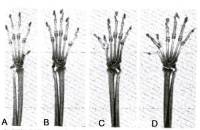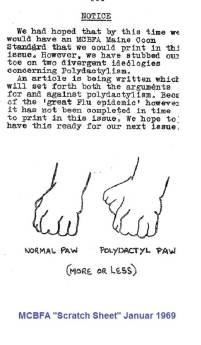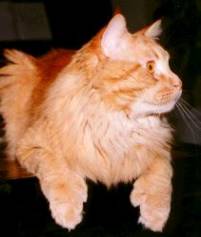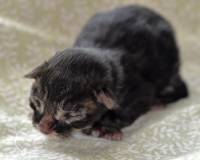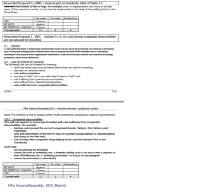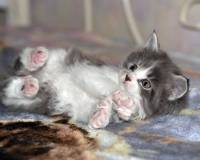The polydactile Maine Coon
At the beginning of the planned breeding of the Maine Coon the gene pool consisted of about 40 % polydactylene (multi-toed) animals. However, since it was already difficult enough to make a "farm cat" a "cat breed" in the US-American associations, it was decided to postpone the recognition of this variant until a later date. This of course did not work and therefore there are regular spiritual wars between Poly opponents and supporters since then whether the Polyvariant should also be admitted to exhibitions on an equal footing with her non-polydactile siblings. Until today it is in all big associations so - except in FIFe, where it is completely forbidden - that this variant is allowed for breeding - or better: not explicitly forbidden - but except in the TICA it is not allowed to compete for the coveted titles at shows.
The expression "polydactile" is of Greek origin: "poly" means "much/more" and "dactyl" means finger/toe. As I understood it, land mammals were originally assumed to have a seven-pointed extremity, which was later reduced to five rays, in the case of ungulates even further (e.g. by merging metacarpal bones). In ungulates, too, there was a development in the opposite direction at first, until monodacylia developed (horses running on the middle finger) or cloven hoofed animals running on two fingers.
So the polydactily, i.e. a "more like five fingers/toes", is in developmental biological terms an atavism, i.e. a setback in development, which represents an early stage in the evolution of the animal from which they once developed. This happens again and again. A natural mutation in the animal kingdom is at first always undirected, i.e. it occurs spontaneously and is first of all completely neutral in itself. It can be that it brings neither advantages nor disadvantages to the animals. If, on the other hand, it brings an advantage, it will absolutely prevail: Darwin's Galapagos finches with their specialized beaks are a good example. Of course, all these characteristics are only snapshots in the course of a progressing evolution which is still in the process of further development - nowadays also controlled by our breeding measures.
Through breeding intervention, a non-natural selection is made, which - unlike biology/nature - does not proceed purely according to the expediency of a mutation, but is subject to personal taste. This can also reveal or favour unfavourable or sometimes even dangerous genes, in the simplest case over-dimension or over-represent characteristics - as we see with the over-typisied "modern" Maine Coons, which "fall out" of the standard of the breed "on the upper side".
Fact is: a selection made by a breeder for a certain trait (until this trait dominates) is always directed - this is the goal in livestock breeding: Improvement of the usable "features" - more milk, more meat, better wool. This possibly also means - besides the "advantage" - an evolutionary disadvantage compared to animals with the "old", unchanged gene: susceptibility to diseases, reduced fertility etc..
What polydactily means in comparison to pentadactily - this can only be speculated about. That the gene for polydactily is silent is the "normal state". If for any reason it is activated (or a suppressor is deactivated), then polys occur. Whether this is "good" or not is not up for discussion here. Pentadactily has - certainly not without reason, but because it promises an advantage - developed in many living organisms through natural selection and selective pressure. But one thing is also certain: Polydactilia has also partially asserted itself and was therefore probably evolutionary in its range (such as single hoofedness in horses, pair hoofedness in cows) also advantageous, but at least neutral. The fact that a polydactily occurs in a species or breed is most probably the result of a spontaneous gene mutation.
It is well known that mutations can often be harmful or even fatal, but we also know that mutations serve as a basis for the development and evolution of species. If a mutation occurs in a population and is not harmful, or even beneficial, then the trait determined by the mutation either simply remains or increases genetic diversity - which is beneficial to the breed as a whole - or it will multiply and eventually become a specific breed trait. This happens when the individual carrying the mutation does not suffer any disadvantage due to his modified gene, but gains a special advantage - as opposed to the animals that do not carry the modified trait. Individuals with an advantage triggered by a mutation are likely to have better chances of survival and thus better chances of mating and reproduction. So more and more individuals will "carry" the "new" trait until it spreads and in the best case (see the Norwegian Lundehund) becomes the dominant breed trait.
While cats usually have 18 toes - five on the forefeet and four on the hindquarters - polydactile or hyperdactile cats have additional toes. These additional toes can either appear equally on all limbs or only on the forefeet or hind paws.
Already Darwin describes polydactily in cats in the 1850s: "I have heard from several families about six-toed cats where this characteristics was inherited in at least three generations". And in 1868, relatively shortly afterwards, we find - from a man with the beautiful name Plotnick - the first scientific presentation of a polydactile cat in the emerging literature.
Polydactily in the Maine Coon, more precisely in its original cat, the Maine Cat, is shown as early as 1876 in a painting by Maine Cat Kittens, all of which show this characteristic. I once saw a photo of it, but unfortunately I didn't save the source completely.
As we have seen above, a cat has five toes on a regular front paw and four toes and an anal claw on a regular hind paw. On a polyfoot, however, we see either additional toes, additional dewclaws or thumbs and sometimes even stumps of toes, some of which are only detectable by x-rays. There are two types of polydactilies, preaxial and postaxial. The preaxial is located on the inside of the paw, with always fully developed toes (these can be either thumbs, toes or additional dewclaws) and the postaxial on the outer edge (in this form it is unlikely that the additional toes are fully developed).
Left: normal toes: / right: polydactile toes
Danforth analyzed the feet of 97 polydactile cats in 1947 and discovered 25 different forms of polydactiliy, ranging from just one additional toe on a front foot (5,6,4,4) to a seventeen "all-wheel drive". (In English polycoons are often affectionately called "4WD" - "all-wheel-drive", "all-terrain"). It is possible to have a different foot configuration on all four feet.
So we can say that there are two main types of physical expression in polydactile cats. One is known as "middle paws", the other as "patty foot" or snowshoe. In the case of the latter, there are surplus toes on the medial side of the foot, "middle paw" is the most common - resembling the human hand, the other form - "patty foot" - is more an addition of toes, often associated with an absent dew claw, is less common. Both types are bred without known problems.
In the just mentioned 1947 study by Danforth the first observations on polydactilie inheritance were published. Danforth investigated a total of 234 kittens in 55 litters and came to the conclusion that polydactilia is caused by a dominant gene, is not sex-linked and is not lethal even with homozygous expression. If I remember correctly: he writes "semi-lethal" and that was used as basis for the poly-passus of the revised German animal welfare law of §11TSchG, which forbids breeding with it, because it was translated incorrectly and despite the protests of the interviewed cat breeding associations. Thankfully so far this is the only state-inflicted measure on polys- associations have made their own decisions though.
In 1998, Solveig Pflüger, an American geneticist, once again investigated the subject of polydactilia. She postulated that there are at least two different genes that trigger a polydactilie: the first - the preaxial form - is simply inherited dominantly autosomal and does not show any negative effects on the health of the Cat. The second, however, causes radial hypoplasia leading to absence and underdevelopment of radius bones. Later, in 2006, Karen Comings, reinforcing her, found that two independent genes actually exist: "Pd" - the gene of polydactilia itself - as an autosomal dominant trait with almost 100% do-minance - which poses no danger to animal health, and "Rh" - the "Radial Hypoplasia Gene", which expresses itself in unusually small twisted radial bones or their complete absence, triggering what she calls "twisted cat". It must be stressed that the Maine Coon only carry the preaxial form of polydactyly.
Polydactilia is therefore a dominant inheritance in cats and the normal toe constructor is recessive. To get poly kittens it is enough to have a parent with polydactilia. This means that if a kitten inherits the dominant gene - the poly toe structure - from one parent, this kitten will also be polydactile. Of course, it is clear that - if there is no homozygous polydactile inheriting poly- parent in the game - this will have a "non-poly" paired with a "non-poly" and a "straightfoot" kitten. As always with such inheritances it is also clear that poly-kittens cannot fall from "non-poly" parents. (If this is the case, it is likely that an x-ray of the parents' feet will show an "invisible poly" somewhere, i.e. a very bad expression of the characteristic.) Although simple dominance is used to explain the general trait, a more complex genetic explanation is required to explain the different variants of the polydactile foot. But we don't have to deal with that in too much detail here, after all, we are not geneticists.
Polys in the Maine Coons are therefore possibly a naturally occurring step backwards in evolution, i.e. not a mutation in the true sense of the word, because it would occur spontaneously. The predisposition to this is stored in the genes of all cats and in this case it is again effective. However, the fact that polydactily appears more frequently in Maine Coons than in other cats is certainly due to a familial mutation in one or more genes that are otherwise suppressed.
I am convinced that polydactile Maine-Coons are not "the devil's work", but only an optical preference of a breeder for or against, because, as shown, neither research nor studies have ever revealed any disadvantages of the Maine Coon's predominant form of polydactilia. (However, injuries to the additional toes appear to be more common than injuries to the others.
Polydactily is often explained in the Maine Coon - I call it the "winter theory" - with its assumed origin from the US state of Maine - where winter is long and hard with lots of snow and ice. Wildcats and only loosely tethered domestic cats feed mainly by fishing and hunting. It is easy to imagine that polydactile cats can climb an icy tree more easily - thanks to their "hands" - or catch fish more easily. However, it must be stated once again that there were no "wild cats", i.e. "felis silvestris" - i.e. definitely no polydactile cats - on the American continent before the first European settlers appeared there. So here we ALWAYS have to do with domestic cats, sometimes running wild, but mostly probably tied to the life with humans..
Also the "snowshoe theory" (the big feet prevent the snow from collapsing) probably originated in this way - although we also have this theory with the normal-footed animals: here it refers to the tufts of hair between the toes. That's one reason why I'm not really convinced by the "snowshoe theory", the second one is climatically conditioned, because we're not talking about polar regions. Maine is located in the so-called cool-moderate zone, with a continental climate with comparatively warm summers, but also very hard winters, and a coastal area about 30 km into the country where the temperatures are more moderate than in the interior due to the proximity of the sea. Hurricanes are the exception in Maine, there are rarely hurricanes, but often the "coastal storms", which bring strong rain and wind, are also snow in winter. On the other hand, Maine is about the same latitude as Lake Como and Jesolo. This is often forgotten because the continental and coastal climate of the American continent is different from that of the "peninsula" Europe..
I personally "like" the "Ship Cat Theory" - according to which Polydactily was a useful "feature" for ship cats at its best. The explanatory theory is that polydactile cats were ostensibly particularly appreciated for their exceptional climbing and hunting skills in combating rodents on board and were therefore very popular as ship cats. In addition, sailors also believed that these "special" cats would bring them much happiness at sea. Although there is some controversy as to whether the most common variant of the trait originated as a mutation in New England or was brought there from England, for example, there is agreement that it has spread widely due to ship cats on ships from Boston, and the prevalence of polydactilia in cat polypolations correlates with the data showing trade with Boston (Cornell University, 1998). A simple explanatory model is the famous "Hemingway Cats" in Key West, Florida: Hemingway also got his first poly from a captain. But I confess - I don't KNOW that any more than anyone else. All we have are theories.
Anyway, we can say once again: The mutation, however and whenever it arose or appeared in the Maine Coon, is obviously not harmful and may have an evolutionary advantage. In my opinion it is not extinct or exterminable.
Most descriptions of our breed - the oral sources such as the written ones - mention as a fact that about 40% of Maine Cats were poly-dactile cats before they were recognized as Maine Coons in the various American associations. There is of course no scientifically valid data to support these figures, but they seem to be correct in consideration - as far as we can see over the last 60 years. (Besides the Maine Coon, there is another American breed in which the Polydactily is desired and recognized: the Pixie-Bob, which is much younger than the Maine Coon).
Now one could ask oneself: since one does not know when both the "breed" - i.e. the "original form" - and the polydactile expression have developed: how would the amount of polys in regard to the whole and the "face of the breed" look if the breed had not been "streamlined" by the MCBFA according to plan for recognition after 1968. We do not know.
Let us recall the history of the Maine Cat and the Maine Coon. At the beginning of the 20th century, when the breed reached its first peak of popularity, and later in the 1950s, the Polys took part in shows together with the standard feet. We know that after 1908 the breed fell into decades of slumber and was almost forgotten, which only changed in the 1950s and 1960s.
In the first standard of the CMCCC they were still mentioned and in the pre-standard of the Maine Coon which the MCBFA, which founded in 1968 to bring the breed into the stud books and the exhibition halls to the "Championship", created the polydactile Maine Coons were still with the following wording: "The Maine Coon Polydactyl Cat should correspond to the standard of the Maine Coon Cat, with the exception that several toes on front or hind paws or both are permitted". Already at that time there were different opinions whether it was good to keep the "thing with the Polys", because the resistance of the American breed cat associations - namely the CFA, which recognized them last, although they were shown there first in their first bloom - against the "unaristocratic" "barncats", farm cats, was big and one feared that one would never achieve a recognition with a cat breed with Polydactilia.
This article mentioned here was obviously never written - at least I didn't find it in any of the following years of the "Scratch Sheet". In the next issue - April 1969 - there is a standard - created by Sonya Stanislow - the IFC, printed - but it is already without polys. Nevertheless they were there and had great supporters among the representatives of the MCBFA, namely the president. The argument weighed back and forth, but "reason" seemed to triumph over love.
So the standard was separated into "non-poly" and "poly" and it was decided to bring the poly relatives "sometimes" to recognition as well. As I said, at that time there were already different aestethic views on how to handle the "problem". The article inserted here from the "Scratch Sheet" by the way reads like a description of the state of some of the current problems. So nothing has changed over the last 50+ Years.
Since the Polys never made it to an "official standard" again, they fell behind against their normal-footed relatives over time and their number shrank in relation to the steadily growing number of "normal-footed" Coons. In the "Showhall" they were never seen, so they fell out of the memory of many, who started to breed "sometime afterwards" - especially as in the time before the internet so much information was lost, because not easily reachable. That's why the poly animals weren't multiplied, "developed" and above all sold in masses like their "straight"-foot siblings. (Breeding however was never "forbidden" and it was also still bred with polydactile animals - also in Europe, where many, many animals have with "MtKittery Socko P" (*1990) a polydactile tomcat in the pedigree, without knowing it. Dorthemarie Kaplers (Guldfakses), who bought him as "pet", remembers and shows the attitude of many FIFe breeders of her time:
"I changed my plans of not breeding with him when I saw him develop. He had size, muzzle, boning, muscles, a very feral look - and a wonderful temperament. I would have died to get all these things into my breeding, so I started using him. A couple of other breeders were also invited to use him, and I put down rules about the polydactyls. No polydactyl male kitten can be used for breeding, only the normal 5/4 males. Polydactyl females can have one litter per year. The reason for this is that a polydactyl male used regularly can produce many kittens with extra toes. A female used once a year does not. I want to make it very clear that I never intended to have a group of polydactyls - and I never wanted them to be recognised. I wanted all the good things mentioned above, not the extra toes. I now have a great-grandson of Molly P, the mother of Socko. He is close to the goal of what I wanted. I also have a great-granddaughter of Molly, and again I am very satisfied. Type, temperament and no extra toes.“
Maine-Coon-Polys were used for a long time only by poly-enthusiastic breeders for breeding, who worked especially with the old lines - here you have to distinguish "old", less known and nearly extinct lines (although only a few of them worked with polydactile animals) and the so called "new Foundations" (which astonishingly also gave the Polys a big boost): one of the centres of renewed interest in the polycoon is North and Central Western Europe, as well as the interest in "New Ways" - be it "New Foundations" or the over-typification towards the "new look" - is something very European - which led to today's polys in the USA mostly having European and "New Foundation" backgrounds, which can be anything.) . Only with the upswing of the Internet and the interest in "new ways" in breeding did the Polys once again come into their own. (of course every upswing, every success is followed by various problems - so mindfulness in breeding is necessary here and everywhere).
As Dorthemarie Kaplers already writes: Polydactile Maine Coons were appreciated for their heavy bone structure, robust health and wonderful temperament. Whereby: the latter two distinguish ALL Maine Coons, even if the first animals brought here to Germany were kind of fierce so some veterinarian dared to touch them only with lobster gloves.
The Poly breeders didn't give up to finally bring the Poly-Maine Coons into the world of shows and let them be accepted as standard. Finally in 2005 an international association called "PolyStandard" was founded to achieve this goal. After a very difficult and from all sides fiercely waged fight also within the different factions of this group (Zealots against Balancing ones, Realists and Rationalists against Utopians), which definitely made the "fight against the outside" and before all against the opposing members of the different Breed Councils more difficult, TICA and other associations were finally provided with sufficient supporting data on the Polycoons to enter into a meaningful discussion with the associations. Most of them, however, refused this discourse.
At the TICA it was all about entering the "New Traits Division" and the further promotion to the "Championship Status". In 2008 and 2010 there was a worldwide vote among the TICA-affiliated breeders regarding a change in the breed standard, but in these attempts it was not possible to achieve a satisfactory result within the TICA due to the prejudices of some members of the former TICA Breed Council MCO, even if a clear rethinking within these two years was to be seen. And only in May 2015, after again long discussions and stormy debates, a compromise was found - disliked by the Polyfanatics as well as by the "Anti-Poly-Fraction" among the "traditional" breeders - which included the "Maine Coon Polydactyl" as sister breed and part of the Maine Coon Breed Group (MCO/MCP) in the Championship. The number of toes was limited to seven. In the meantime we see the first higher champions here, and also the demand for optical adaptation of the polycoons to the predominant optics is largely implemented.
In CFA, Poly Maine Coons can still only be displayed as neuters in the HHP Category. Restrained as the CFA is - it took her about 50 years to recognize the ticked-tabby variant in the Maine Coon - I'm afraid it won't change so quickly.
The New Zealand Cat Fancy (NZCF) included polydactile Maine Coons in the champion ring in 2008, so they have been shown together with their normal-footed competitors ever since. With the Australians and the other associations represented in the WCC (ACF, CCC of A, GCCF and SACC) I don't know at the moment - I admit it. For many in Europe it's interesting that the WCF, which is a FIFe spin-off - and relatively similar to this in general - still follows the old "dont ask-don't tell" rule: Breeding yes, show no. But also here breeders try to bring the Polys into the shows and to their right.
FIFe, on the other hand, banned breeding with polydactiles in 2013 (funnily enough, breeding with the definite lethal factor Manx mutation is still allowed). The main reason why the board and some FIFe judges do not want to see polydactile Maine Coons in the show halls and breeding programs was primarily aesthetic, and it has been claimed that the polydactile gene poses a risk to the breed. This was laid down in an application of the judges, standard commission and the board and the "total ban", i.e. neither breeding nor show, was demanded. The Breed Council, of which I was chairman at that time, spoke against it in its advisory function - our main argument was that one could not remove a part of a breed that was already in danger of facing a new genetic bottleneck due to the HCM crisis after "Meurs", especially when any lethal factor was not to be seen. Also one does not slam doors without necessity, which then can be reopened only with difficulty or no anymore. So we voted to keep the "status quo" - "breeding yes, show no" - and to reject the application. The national Maine Coon Clubs from Denmark, Finland and Italy voted with the Breed Council, the Dutch were divided: one club had submitted an opposing application for full recognition, the other - already due to the eternal competition between the two Dutch FIFe members (there is traditionally only one national FIFe member association per country, here in Germany the 1.DEKZV, in The Netherlands and Austria however for historical reasons there are two members each - and they are anything but happy which each other) was strictly in line of the board. The Dutch request for show recognition was quickly knitted and demanding and lacked any caution. I had clearly pointed out that this could lead to polys being banned in FIFe and had asked not to apply when I was asked. They did not listen to me and so it came as it should. If this "pro" motion had not come, the board's motion would - I was there - have been suspended and nothing would have changed: but so was the committee - the entire voting General Assembly of the FIEe with 32 against 3 with four abstentions for a ban of the Polydaktilie in general.
Finis Polydactilia in the FIFe. And this actually only because of "old rivalries" and short-sighted action. Something which determines the fate of the polydactile Maine Coon since the breeds recognition.
And there we are now: In a cat breeding world that is still split when it comes to "Polys": from aggressive negators to equally aggressive proponents. Polys are often praised as something "special" (which is also reflected in the price) - but they are only an integral, albeit small, part of our breed - whose breeding is simply a matter of taste. A normal handling with it, without blinkers, ideological positions and reservations would therefore be appropriate..

